Tuina combined with needling distal points for pseudo-myopia in adolescents
Li Lin-ping (李琳苹), Jin Cheng-zhong (金城钟)
1 Taizhou Hospital of Traditional Chinese Medicine, Zhejiang 318000, China 2 Taizhou Municipal Hospital, Zhejiang 318000, China
Tuina combined with needling distal points for pseudo-myopia in adolescents
Li Lin-ping (李琳苹)1, Jin Cheng-zhong (金城钟)2
1 Taizhou Hospital of Traditional Chinese Medicine, Zhejiang 318000, China 2 Taizhou Municipal Hospital, Zhejiang 318000, China
Objective:To observe the clinical effect of tuina combine with needling distal points for pseudo-myopia in adolescents.
Acupuncture Therapy; Ocular Health Tuina; Massage; Myopia; Adolescent
Myopia is a condition of the eye involving refractive error and often affects adolescents. In 2010, the 6th large-scale investigation report of constitution and health for Chinese students showed that poor vision tends to affect younger children[1-2]. Consequently, it’s of great significance to prevent and treat myopia in adolescents. Clinically, there are true and pseudo myopia. Pseudo-myopia refers to intermittent and temporary shift in refraction of the eye due to ciliary muscle strain or fatigue but can restore to normal after rest or using paralysor. However, once pseudo-myopia becomes true myopia, individuals have to wear glasses. We’ve treated pseudo-myopia in adolescents between January 2010 and October 2014 with tuina combined with needling distal points. The results are now summarized as follows.
1 Clinical Data
1.1 Diagnostic criteria
This was based on theDefinition and Categorization Criteria for True and Pseudo-Myopia(Draft) stipulated in the 1st National Academic Conference on OcularRefraction[3]. Pseudo-myopia: far visual acuity is lower than normal, normal near visual acuity, absence of myopia upon ciliary muscle paralysis by atropine and presence of emmetropia or mild hypermetropia. True myopia: the myopia diopter is not decreased or decreased by < 0.50D. Mixed myopia: notable decrease of myopia diopter (≥0.50D) but unable to restore to emmetropia.
1.2 Inclusion criteria
Those who met the above diagnostic criteria for pseudo-myopia (far visual acuity <5.00D and normal near visual acuity); absence of or ≤0.50D of astigmatism; aged between 5 and 16 years; and those who could stick to 3 treatment courses and allow for re-examination of far visual acuity and diopter.
1.3 Exclusion criteria
Those who didn’t meet the above diagnostic and inclusion criteria; presence of >0.50D astigmatism; and having other eye problems that may cause poor eyesight or used other therapies.
Those who withdrew from the study or failed to complete the treatment courses were considered as dropouts.
1.4 Statistical methods
The SPSS 16.0 version software was used for statistical analysis. Pairedt-test was used for measurement data, which were expressed in the form ofThe Chi-square test was used for enumeration data. APvalue of less than 0.05 indicates a statistical significance.
1.5 General materials
A total of 64 pseudo-myopia (both eyes) adolescents treated between January 2010 and October 2014 were recruited in this study. They were allocated into a treatment group and a control group by the random number table, 32 in each group (64 eyes). Cases in the treatment group were aged between 5 and 16 years. Their duration lasted from 3 to 18 months. The uncorrected visual acuity before treatment was 4.3-4.8. Cases in the control group were aged between 5 and 16 years. Their duration lasted from 3 to 18 months. The uncorrected visual acuity before treatment was 4.3-4.8. There were no between-group statistical differences (P>0.05) in gender, age, duration and uncorrected eyesight before treatment, indicating that the two groups were comparable (Table 1).

Table 1. Between-group comparison of general materials
2 Treatment Methods
2.1 Treatment group
2.1.1 Tuina therapy[4]
Points: Yintang (GV 29), Cuanzhu (BL 2), Yuyao (EX-HN 4), Sizhukong (TE 23), Taiyang (EX-HN 5), Qiuhou (EX-HN 7), Chengqi (ST 1), Jingming (BL 1), Sibai (ST 2), cervical vertebrae, Fengchi (GB 20), Ganshu (BL 18), Pishu (BL 20), Shenshu (BL 23) and Yongquan (KI 1).
Method: The patient took a supine lying position. The practitioner sat facing the patient’s head and applied the following manipulation by sequence: 50 times of Kai-opening Tianmen [also named Tui-pushing Cuanzhu (BL 2)], (Figure 1) and Tui-pushing Kangong (superciliary arch), (Figure 2) respectively; approximately 10 min of Rou-kneading Yintang (GV 29) (Figure 3), Cuanzhu (BL 2), Yuyao (EX-HN 4), Sizhukong (SJ 23), Taiyang (EX-HN 5) and Sibai (ST 2), (Figure 4) using the index and middle fingers and An-pressing and Rou-kneading Jingming (BL 1) using the thumb on both eyes alternately (Figure 5); 3-5 times of Wa-rubbing medial sides of the eye sockets (Figure 6) and approximately 2 min of Anpressing and Rou-kneading Chengqi (ST 1), Qiuhou (EX-HN 7), Rou-kneading Tianzhugu (cervical vertebrae), (Figure 7), and An-pressing and Rou-kneading Fengchi (GB 20), (Figure 8). Then the patient took a prone lying position. The practitioner stood on the right side of the patient and applied 2-3 min of An-pressing and Roukneading to Ganshu (BL 19), (Figure 9), Pishu (BL 20), Shenshu (BL 23) and Yongquan (KI 1) and concluded by 4-6 times of Nie-pinching the spine (Figure 10).

Figure 1. Kai-opening Tianmen
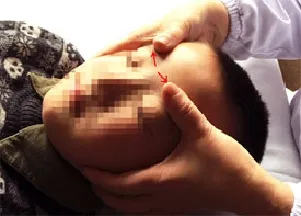
Figure 2. Tui-pushing Kangong (superciliary arch)
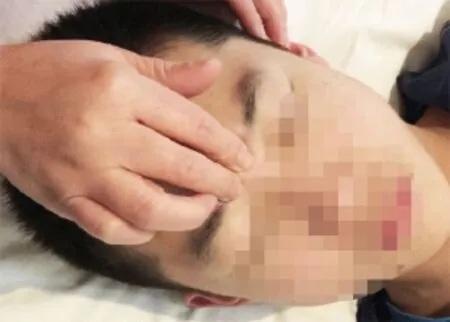
Figure 3. Rou-kneading Yintang (GV 29)
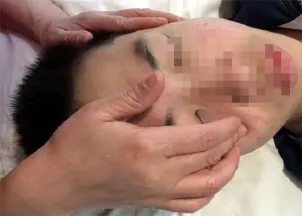
Figure 4. Rou-kneading Sibai (ST 2)
Cautionary notes: The practitioner needs to concentrate his/her attention and apply gentle manipulation to avoid patient’s nervousness.
2.1.2 Acupuncture therapy[5]
Points: Hegu (LI 4), Taichong (LR 3), Xingjian (LR 2), Zusanli (ST 36), Guangming (GB 37), Taixi (KI 3) and Sanyinjiao (SP 6) on both sides.
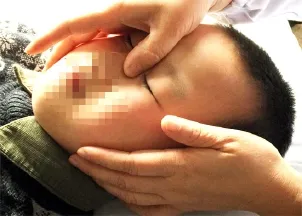
Figure 5. Rou-kneading Jingming (BL 1)
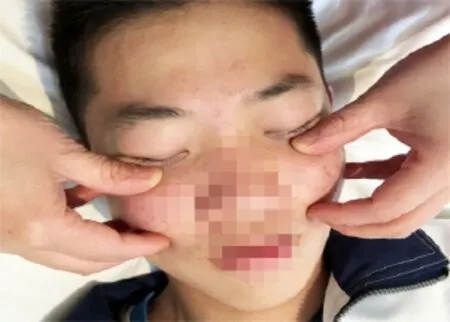
Figure 6. Wa-rubbing the eye socket
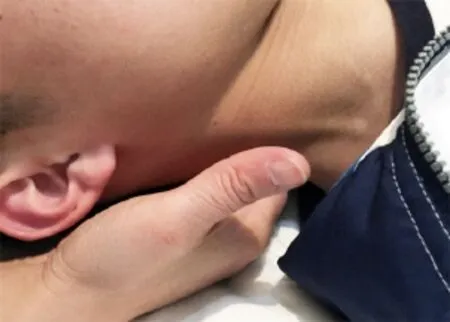
Figure 7. Rou-kneading Tianzhugu (the cervical vertebrae)
Method: The patient took a supine lying position. After routine sterilization, the above points were punctured with filiform needles of 0.25 mm in diameter and 40 mm in length, followed by even reinforcing and reducing manipulation upon arrival of qi. The needles were retained for 30 min.
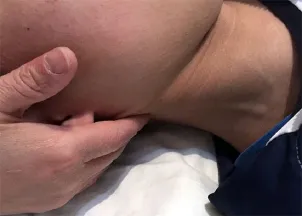
Figure 8. Rou-kneading Fengchi (GB 20)

Figure 9. Rou-kneading Ganshu (BL 18)
The patients were treated with tuina first and then acupuncture. The treatment was done once a day for 10 d as a course. They were treated for a total of 3 courses. There was a 2-day interval between two courses.
During the treatment, the patients were encouraged to conduct more outdoor physical exercise, see more green plants and avoid poor eye-care habits.
2.2 Control group
Cases in the control group were treated with the same tuina method (points, manipulation and treatment course) as the treatment group.

Figure 10. Nie-pinching the spine
3 Treatment Effects
3.1 Therapeutic efficacy criteria
This was based on the Diagnosis and Therapeutic Efficacy Assessment for Common Diseases (Criteria)[6], using the standard logarithmic visual acuity chart to examine uncorrected far visual acuity.
Short-term recovery: Absence of all or major clinical symptoms, >1.0 of far visual acuity, absence of diopter by retinophotoscopy and presence of emmetropia.
Marked effect: Almost absence of all or major clinical symptoms, far visual acuity increased by 3 or more lines and noticeably decreased (≥1.00D) diopter by retinophotoscopy.
Improvement: Alleviated clinical symptoms, far visual acuity increased by 2 lines and decreased (≥0.50D) diopter by retinophotoscopy.
Failure: Somewhat improved or unchanged clinical symptoms, far visual acuity increased by 1 line and decreased (<0.50D) diopter by retinophotoscopy.
3.2 Treatment results
After treatment, the total effective rate was 92.2% in the treatment group, versus 82.8% in the control group, showing a statistical significance (P<0.05) and indicating a better effect in the treatment group than that in the control group.

Table 2. Between-group comparison of clinical effects (case)
4 Discussion
Myopia is characterized by blurry distance vision, but generally good near vision. Other than poor visual environment (including light pollution), near range and long hours of reading, myopia is also associated with factors such as environment, heredity, development and insufficient sleep[7-10]. In Chinese medicine, factors contributing to myopia include congenital deficiency, maldevelopment, qi and blood deficiency of the heart, liver and kidney and poor eye care. These factors can cause malnourishment of the eyes and lead to myopia.
In this study, distal points below the elbow and knee joints were selected based on the theory that ‘treating problems of the upper body from the lower body’. The root of meridian qi lies in four extremities. Needling these points can stimulate meridian qi, regulate Zang-fu organs, unblock flow of meridian qi around the eyes, harmonize qi and blood and thus benefit the eyes and improve myopia. Of the points selected, Sanyinjiao (SP 6), a crossing point of the Liver, Spleen and Kidney Meridians, can circulate blood, tonify the liver and kidney and help with transportation and transformation; Taichong (LR 3), the Shu-Stream and Yuan-Primary point of the Liver Meridian, can harmonize qi and blood, unblock meridians, and benefit the eyes when used in combination with Zusanli (ST 36), Guangming (GB 37), Sanyinjiao (SP 6) and Hegu (LI 4); and Guangming (GB 37) is a common point for eye problems. Other points for eye problems include Yintang (GV 29), Cuanzhu (BL 2), Taiyang (EX-HN 5), Qiuhou (EX-HN 7), Chengqi (ST 1), Jingming (BL 1) and Sibai (ST 2). Application of tuina to these points can improve blood circulation of the eyes, alleviate ciliary muscle spasm and eliminate eye fatigue[11-14]. Acupuncture combined with tuina can enhance the function of harmonizing qi and blood and improve eyesight.
Based on the previous studies[14-16], this study used tuina combined with needling distal points for pseudo-myopia in adolescents and obtained better effect than conventional tuina. Since we primarily use tuina and supplement with needling distal points, this method is easy to be accepted among adolescents and worthy of further clinical application.
We’ve also found that the treatment effect is associated with pre-treatment eyesight and age. Those with better eyesight obtained better effects than those with poor eyesight. Those with a younger age (<10 years old) tend to have better effects than those with an older age. Consequently, early intervention is important for myopia.
Conflict of Interest
The authors declared that there was no conflict of interest in this article.
Statement of Informed Consent
The informed consent was obtained from all individual participants included in this study.
Received: 5 December 2014/Accepted: 12 January 2015
[1] Xie HL, Xie ZK, Ye J, Yang XJ, Qu J. Analysis of correlative factors and prevalence on China’s youth myopia. Natl Med J China, 2010, 90(7): 439-440.
[2] Research Group of Constitution and Health for Chinese Students. Investigation Report of Constitution and Health for Chinese Students in 2010. Beijing: Higher Education Press, 2012.
[3] Group of Dioptrics, Chinese Medical Association of Ophthalmology. Definition and categorization criteria for true and pseudo-myopia (draft). Zhonghua Yanke Zazhi, 1986, 22(3): 184.
[4] Zhang SF. Chinese Pediatric Tuina. Shanghai: Shanghai College of Traditional Chinese Medicine Press, 1992: 210.
[5] Wang QC. Acupuncture Therapeutics. Beijing: China Press of Traditional Chinese Medicine, 2007: 36.
[6] Wu SZ. Diagnosis and Therapeutic Efficacy Assessment of Common Diseases (Criteria). Beijing: China Press of Traditional Chinese Medicine, 1999: 805.
[7] Wang RF. Current status and problems in the study of myopia. Chin J Opthalmol, 2003, 39(6): 381-384.
[8] Ou LR, Bao JH, Wang YW, Lü F. Research on reading behavior and related factors of myopic children. Yan Shiguangxue Zazhi, 2008, 10(2): 84-85.
[9] Yao JL, Xiao L, Xu B, Liu L. Investigation report analysis on constitution index and uncorrected visual acuity in 1 839 middle school students from Beijing. Beijing Yixue, 2008, 30(3): 184.
[10] Lai LF. The culprit of myopia in children. Jiaoyu Daokan: Youer Jiaoyu, 2003, 4(1): 63-64.
[11] Chen S, Qi FJ, Liu JM, Fan Y, Liu XQ. Clinical observation on tuina combined with ear seeds for pseudo-myopia in adolescents. Shiyong Zhongxiyi Jiehe Linchuang, 2013, 13(7): 3, 18.
[12] Zheng HY, Ma H, Fu B. Massage for pseudo-myopia in 48 adolescents. Shiyong Zhongyi Neike Zazhi, 2007, 21(3): 104.
[13] Zhang J, Jin LT, Ma YQ, Lu Q, Wang J, Li CY. Short-term therapeutic efficacy observation on three-step tuina combined with ear seeds for myopia in adolescents. Shizhen Guoyi Guoyao, 2013, 24(11): 2693-2694.
[14] Zhao ZH, Lu GJ, Yu WQ, Huang XH, Pan P, Cheng JP. Observations on the efficacy of plum-blossom needle therapy plus massotherapy for juvenile pseudomyopia. Shanghai Zhenjiu Zazhi, 2013, 32(7): 579-580.
[15] Li XH, Liu YC, Gong FM, Qi XY, Guo XD, Liu GD, Hou DM. Clinical study on acupuncture for treatment of juvenile moderate and mild myopia. Zhongguo Zhen Jiu, 2003, 23(3): 147-149.
[16] Jia N. Literature analysis of treating youth pseudomyopia by acupuncture. CJCM, 2012, 4(4): 121-122.
Translator:Han Chou-ping (韩丑萍)
推拿结合远道取穴针刺治疗青少年假性近视
目的: 观察推拿结合远道取穴针刺治疗青少年假性近视的临床疗效。方法: 将 64名青少年假性近视患者按随机数字表随机分为治疗组和对照组, 每组32例(64只眼)。治疗组采用推拿结合远道取穴针刺治疗, 对照组采用单纯推拿治疗, 推拿手法、推拿部位及治疗时间均与治疗组相同。每日治疗1次, 连续10次为1疗程, 休息2 d后继续下一个疗程, 共治疗3个疗程。两组患者均在接受3疗程治疗后进行标准对数视力表检测裸眼远视力和散瞳后检影验光近视屈光度检测, 观察其近期疗效。结果: 治疗3个疗程后, 两组患者视力均较治疗前有改善;治疗组总有效率为92.2%, 对照组为82.8%, 两组总有效率差异有统计学意义(P<0.05), 提示治疗组疗效优于对照组。结论: 推拿结合远道取穴针刺治疗青少年假性近视疗效显著, 而且没有针刺眼周穴位带来的恐惧, 易于被青少年接受, 值得在临床上推广应用。
针刺疗法; 眼保健推拿; 按摩; 近视; 青少年
R244.1 【
】A
Author: Li Lin-ping, bachelor, attending physician.
E-mail: 1302528567@qq.com
Methods:A total of 64 adolescents with pseudo-myopia were allocated into a treatment group and a control group by the random number table, 32 cases in each group (64 eyes). Cases in the treatment group were treated with tuina combined with needling distal points, whereas cases in the control group were treated with the same tuina method (manipulations, treatment area and time) as those in the treatment group. The treatment was done once a day for 10 d as a treatment course. They were treated for 3 courses and there was a 2-day interval between two courses. After 3 treatment courses, all cases were re-examined for the short-term effect on uncorrected eyesight using the logarithmic visual acuity chart and on diopter using retinophotoscopy.
Results:After 3 treatment courses, the visual acuity in both groups was improved. The total effective rate was 92.2% in the treatment group, versus 82.8% in the control group, showing a statistical significance (P<0.05) and indicating a better effect in the treatment group than that in the control group.
Conclusion:Tuina combined with needling distal points is remarkably effective for pseudo-myopia in adolescents. Since it doesn’t cause fear (from needling local points around the eyes), it’s easy to be accepted by adolescents and worthy of further clinical application.
 Journal of Acupuncture and Tuina Science2015年3期
Journal of Acupuncture and Tuina Science2015年3期
- Journal of Acupuncture and Tuina Science的其它文章
- Efficacy observation on acupuncture-moxibustion for urinary retention after surgery for cervical cancer
- Therapeutic observation of acupuncture plus heat-sensitive moxibustion for chronic pelvic inflammatory disease
- A controlled study on treatment of acute lumbar sprain by acupuncture at Yaotongdian (EX-UE 7) plus tuina manipulation
- Effect of complex reinforcing-reducing manipulation on lower limb motion and balance disorder in patients with subacute combined degeneration of the spinal cord
- Clinical study on skin needling plus heat-sensitive moxibustion for chronic facial paralysis
- Effect of tuina manipulations on blood pressure and its variability in hypertension patients
